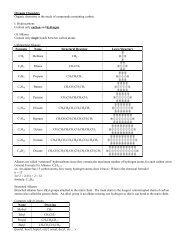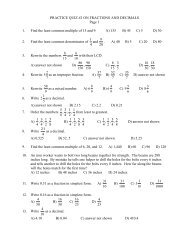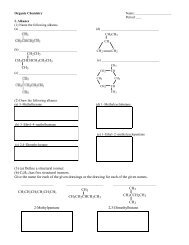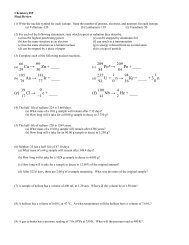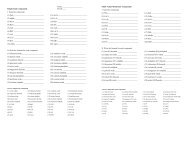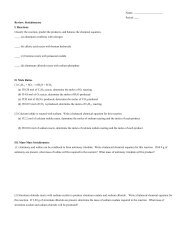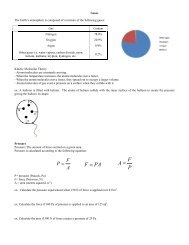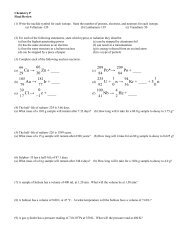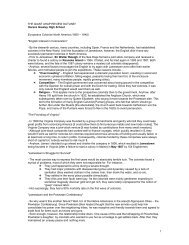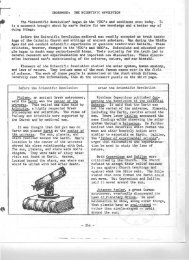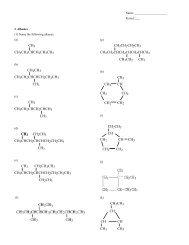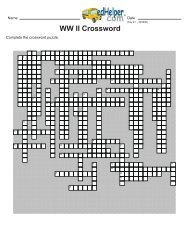10826 AP Chemistry Chemical Equations Worksheet
10826 AP Chemistry Chemical Equations Worksheet
10826 AP Chemistry Chemical Equations Worksheet
Create successful ePaper yourself
Turn your PDF publications into a flip-book with our unique Google optimized e-Paper software.
<strong>AP</strong> <strong>Chemistry</strong> <strong>Chemical</strong> <strong>Equations</strong> <strong>Worksheet</strong>Answer KeyChanges to the <strong>AP</strong> <strong>Chemistry</strong> Exam format for 2007 include modification to Question 4 in Section II. Previously, studentswere asked to write chemical equations for any five of eight given sets of chemical reactions. The new format requires studentsto write balanced chemical equations showing only the reacting substances (excluding spectator ions) for three different setsof reactants and to answer a short question (requiring no calculator) about each reaction. The questions are intended to test thestudents’ understanding of the meaning of the reactions.The College Board has provided only a few examples of the types of questions that might be asked. (Visit the CollegeBoard Web site at www.apcentral.collegeboard.com/apc/public/courses/150180.html?type=print for examples.) <strong>AP</strong> <strong>Chemistry</strong>teachers have asked us if we have any products or worksheets to address this new format. The following list of practicechemical equations is provided as a helpful tool to assist teachers. We have compiled these questions based on our interpretationof the questions on the College Board Web site. Flinn Scientific has no additional information or guidance other than thatprovided by the College Board on its Web site.In each of the 38 reactions listed below, a representative question about the reaction and the answer to the question areincluded, along with the balanced chemical equation. We hope that you will find this worksheet helpful in preparing studentsfor the new <strong>AP</strong> <strong>Chemistry</strong> chemical equation section.(a) A solution of ammonia is added to a dilutesolution of acetic acid.NH 3+ CH 3COOH → NH+4+ CH 3COO –(b) Solutions of sodium hydroxide and acetic acid aremixed.OH – + CH 3COOH → H 2O + CH 3COO –(c) Hydrogen sulfide gas is bubbled through excesspotassium hydroxide solution.H 2S + 2OH – → S 2– + 2H 2O(d) Solid barium oxide is added to distilled water.BaO + H 2O → Ba 2+ + 2OH –(e) Solid calcium oxide is exposed to a stream ofcarbon dioxide gas.Identify the conjugate acid–base pairs in this reaction.Answer: NH 3(base) and NH+4(acid)CH 3COOH (acid) and CH 3COO – (base)Acetic acid is a weak acid. If equal volumes of equalmolar solutions are mixed, will the solution pH be >7, 7,or 7. The salt of a weak acid (CH 3COO – ) isbasic in solution.Write the successive ionization equations for H 2S.Answer: H 2S + H 2O ← → HS – + H 3O +HS – + H 2O ← → S 2– + H 3O +Is the resulting solution acidic, basic or neutral? Explain.Answer: Basic. Metal oxides form basic compounds inwater.What type of reaction has occurred?Answer: A synthesis (or combination) reaction.CaO + CO 2→ CaCO 3(f) Solid dinitrogen pentoxide is added to water.N 2O 5+ H 2O → 2H + + 2NO–3(g) Carbon disulfide vapor is burned in excess oxygen.CS 2+ 3O 2→ CO 2+ 2SO 2Is the final solution acidic, basic or neutral? Explain.Answer: Acidic. Nonmetal oxides form acidic compoundsin water.What is the oxidizing agent in this reaction?Answer: Oxygen.– 5 –Publication No. <strong>10826</strong>Your Safer Source for Science Supplies© 2007 Flinn Scientific, Inc. All Rights Reserved.(800) 452-1261 • Fax: (866) 452-1436 • P.O. Box 219 • Batavia, IL 60510 • E-mail: flinn@flinnsci.com • www.flinnsci.com



